 |
||
FUZZY EXCITATION REGULATION SYSTEMS FOR SYNCHRONOUS GENERATORS
YU. A.Bortsov1, N.D.Polyakhov1, А.А.Yurganov2, I. A.Prikhodko1
1 Saint-Petersburg State Electrical Engineering University,
2
Research Institute for Electric Machinery, Saint-PetersburgАннотация – Задачей исследования явилось построение грубого регулятора возбуждения синхронного генератора на основе принципов нечеткого управления, обеспечивающего требуемое качество регулирования при изменении схемно-режимных условий в энергосистеме. Выполнен сравнительный анализ структур: 1) автоматический регулятор сильного действия с ПД и ПИД-законами регулирования; 2) система регулирования с нечеткими ПД и ПИД-регуляторами напряжения; 3) система регулирования с нечетким системным стабилизатором; 4) нечеткий регулятор напряжения и нечеткий системный стабилизатор; 5) нечеткий регулятор возбуждения. Качество регулирования проверялось в исследовании моделированием внешнего и внутригруппового движения электростанции и по результатам испытаний на физической модели энергосистем. Предложенное управление позволяет расширить область устойчивости генератора без перенастройки параметров регулятора.
In recent years a number of the research publications have been offered to use fuzzy control principles for design of the automatic excitation regulators (AER) for synchronous generators (SG), permitting to change the control algorithms depending on various working conditions of the generator in a power system.
Purposes of the offered research are: the comparative analysis of structures of control SG excitation systems; the evaluation of efficiency of a combination of fuzzy and linear control laws; the expediency of introduction of two fuzzy control channels and analysis of their interaction; the possibility of design of the fuzzy controller a voltage regulator and a system stabilizer. The investigation of control systems includes:
d) fuzzy automatic voltage regulator and fuzzy system stabilizer (FVR and FSS);
The quality of regulation was checked up in a research by simulation of external movement of power station and inside group movement of generators. In the first case the parameters of the generator TBB-320-2 correspond to parameters of the equivalent generator of station; a power system is replaced by the bus constant on a phase of voltage located at centre of electrical hesitations.
In the second case the parallel work of two generators, switched on common bus through a line with a resistance Хe = 0.46 p.u. and joint with a power system network was considered. In the SG
equations the usual assumptions are applied.In structure AER-EO the measuring blocks of voltage, current, frequency are taken into account, which description corresponds to the actual electrical circuits. For want of inside group movement in parallel working generators are connected by positive cross feedback, therefore research by simulation have included an evaluation of quality of regulation for want of switching FSS on one generator, and on the other linear SS, and inclusion two FSS for two generators.
The outcomes of an experimental research results of FSS on an electrodynamic model are indicated in [1].
In a research the traditional structure AER-EO1, consisting of two functionally divided channels was considered: AVR and SS. Standard AER-EO1 adjustments are selected.
The difference of structures with fuzzy blocks is the elemination of
the force block in AVR. In FS as feedback the deviations of frequency of voltage and
active power![]() are used, there is no feedback
on a derivative of excitation current. The previously conducted research [2] has shown
efficiency of selected connections in conditions of the decrease of an equivalent
synchronous generator external resistance up to values
are used, there is no feedback
on a derivative of excitation current. The previously conducted research [2] has shown
efficiency of selected connections in conditions of the decrease of an equivalent
synchronous generator external resistance up to values ![]() .
.
The selected plots of membership functions of a voltage regulator and system stabilizer are shown in a fig. 1 а-e.
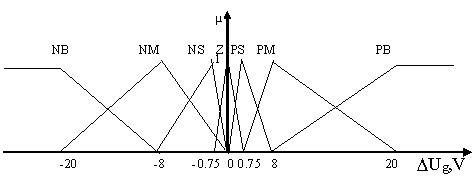 a)
a)
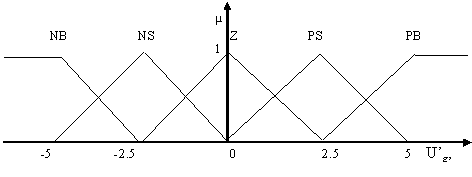 b)
b)
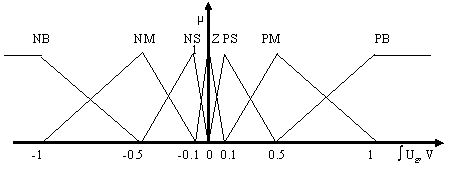
c)
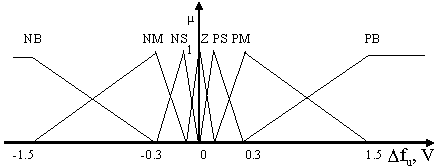
d)
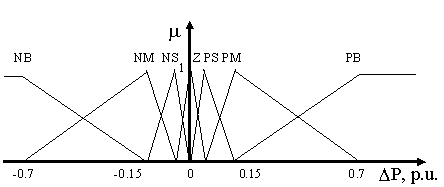
e)
Fig. 1. The plots of membership functions of the fuzzy voltage regulator (a-c), and fuzzy stabilizer (d,e).
The control signal of a voltage regulator and system stabilizer are given in a fig. 2a,b.
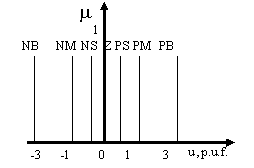
a)
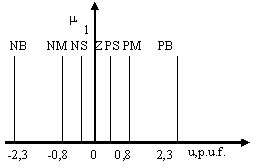
b)
Fig. 2. The plots of membership functions of the control signal of the fuzzy voltage regulator (a) and fuzzy stabilizer (b).
All input variables of the fuzzy controller are the measured voltages by AER-EO1 sensors.
The choice of membership functions and fuzzy control rules was carried out during simulation. In case, when there are three signals of control on the fuzzy controller input, the knowledge base represents a cube. If the third signal equals zero, the coefficients of a plane of a cut of a cube coincide with values of tab. 1, 2. As there is variation of the third signal in the correspondence with the plot of a membership function all factors of a plane of a cut are corrected. For want of design PID of a voltage regulator depending on an integral of voltage value the corrections make up: -0.1, -0.05, - 0.02, 0, 0.02, 0.05, 0.1.
For want of synthesis FEC correction values are determined depending on values of a deviation of voltage of the generator and make up: -2.5, -0.95, -0.45, 0, 0.45, 0.95, 2.5.
The rules FVR are indicated in tab. 1, FS- in tab. 2.
The table 1
|
NB |
NM |
NS |
Z |
PS |
PM |
PB |
PB |
0 |
PS |
PS |
PM |
PM |
PB |
PB |
PM |
NS |
0 |
PS |
PS |
PM |
PM |
PB |
PS |
NS |
NS |
0 |
PS |
PM |
PM |
PM |
Z |
NM |
NM |
NS |
0 |
PS |
PM |
PM |
NS |
NM |
NM |
NM |
NS |
0 |
PS |
PS |
NS |
NB |
NM |
NM |
NS |
NS |
0 |
PS |
NB |
NB |
NB |
NM |
NM |
NS |
NS |
0 |
The table 2
|
NB |
NM |
NS |
Z |
PS |
PM |
PB |
PB |
0 |
PM |
PM |
PM |
PB |
PB |
PB |
PM |
NM |
0 |
PM |
PM |
PM |
PM |
PB |
PS |
NM |
NM |
0 |
PS |
PS |
PM |
PM |
Z |
NM |
NM |
NS |
0 |
PS |
PM |
PM |
NS |
NM |
NM |
NS |
NS |
0 |
PM |
PM |
NM |
NB |
NB |
NM |
NM |
NM |
0 |
PM |
NB |
NB |
NB |
NB |
NM |
NM |
NM |
0 |
The control action was determined according to a weight average method [2].
Comparative performance results of regulation of the excitation controllers with research of external movement of the generator are indicated in tab. 3,4.
The table 3
| Mode | Nominal mode |
Under excitation |
||
| Index Controller |
( ґ 10-3) |
|
( ґ 10-2) |
( ґ 10-2) |
AER-EO1 |
2.85 |
2.85 |
- |
- |
AER -PID |
2.2 |
2.2 |
- |
- |
| UNITROL F | .2.2 |
2.2 |
- |
- |
AVR -AER |
2.0 |
2.0 |
1.15 |
1.1 |
FAER |
2.55 |
2.5 |
0.42 |
0.425 |
| FVR-FSS | 2.1 |
2.05 |
1.6 |
1.55 |
The table 4
Two phase short circuit |
||
Index
Controller |
||
AER-EO1 |
3.95 |
3.95 |
AER-PID |
5.0 |
5.1 |
UNITROL F |
5.5 |
5.5 |
AVR-FSS |
2.7 |
2.75 |
FAER |
1.5 |
1.5 |
FVR-FSS |
1.8 |
1.8 |
The performance of inside group movement regulation is reflected in fig. 3 a,b,c.
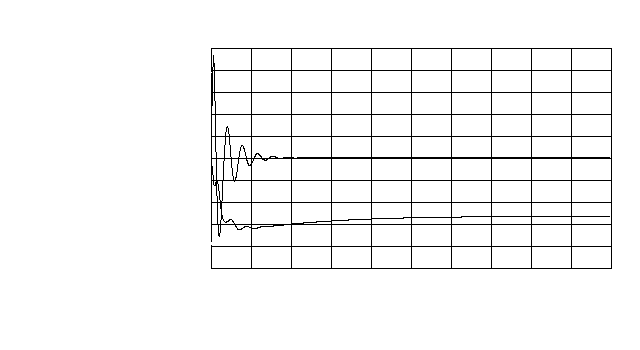
a)
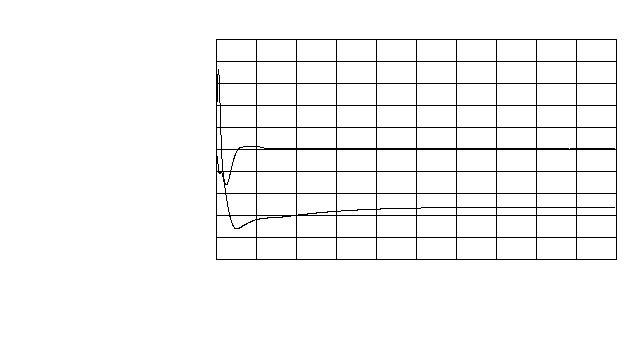
b)
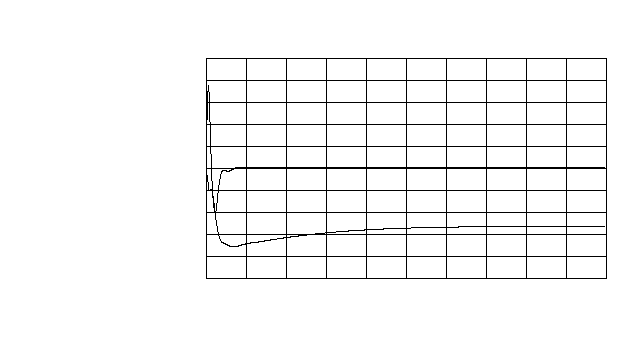
с)
Fig. 3. Transients for want of step perturbation on an input one of the excitation controller: a) switching on AER-EO1; b) switching on AER-EO1on one of generators and control system with an fuzzy stabilizer on the other one; c) switching on the control system with fuzzy stabilizers.
On an electrodynamic model experimentally there were investigated: efficiency of damping of electromechanical oscillations for of small and large perturbations; static stability in modes of under and over excitation; dynamic stability for 3-rd phase a short-circuit. It is obtained, FSS in all modes of over excitation damps small oscillations not worse analog AER with a constant set-up. Both stabilizers ensure an identical limit of static stability conterminous to a settlement limit of oscillatory stability. In modes of under excitation FSS ensures better quality and possibility of stable work in broader band of modes. The Illustrating plots for those modes are shown in a fig. 4a,b for AER-EO1 and control system with FSS, accordingly.

a)
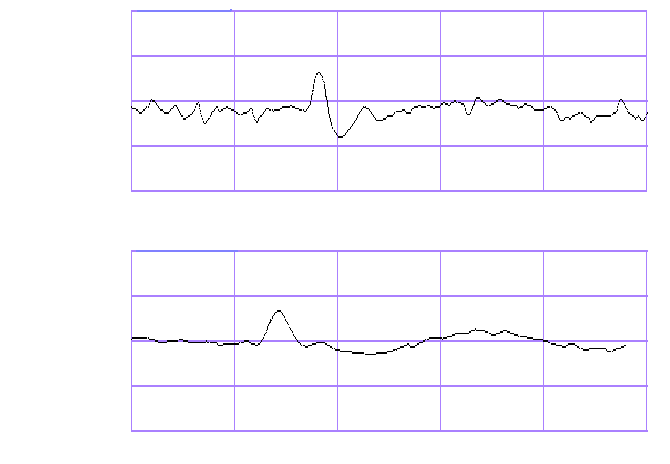
b)
Fig. 4. Damping of oscillations in an under excitation mode a) AER-EO1; b) FSS.
The use FSS has allowed: to increase damping electromechanical oscillations and to expand area of static stability in a mode under excitation without a modification of a structure and tunings of a stabilizer.
The work is executed for want of to financial support of the grant MEI № 01980007015
References
1. Experimental research of the fuzzy stabilizer of the synchronous generator of excitation. /Y.A.Bortsov, A.A. Yourganov, I.A. Prikhodko, V.A. Kojevnikov //
Electrotechnika, 1999, № 3.-P.3-5.2. The synchronous generator excitation stabilizer on the base of fuzzy algorithms principles /N.D.Polyakhov, A.A.Yurganov, I.A.Prikhodko, P.V.Sokolov//First Int. (III All Rus.) conf. on electromechatronics (EMT’97) Proceedings, Saint-Petersburg May 14-16, 1997. - St.-Petersburg: State Electrotechnical University.-p.169-174.
| Site of Information
Technologies Designed by inftech@webservis.ru. |
|